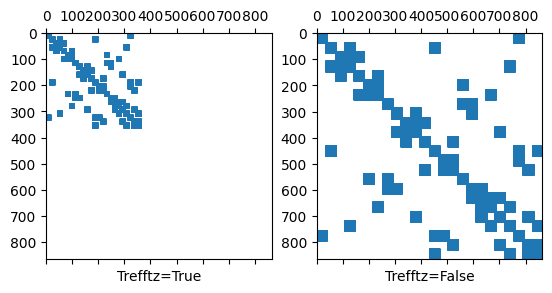Laplace
We are looking to solve
\[\begin{split}\begin{align*} \begin{split}
\begin{cases}
-\Delta u = 0 &\text{ in } \Omega, \\
u=g &\text{ on } \partial \Omega,
\end{cases}
\end{split} \end{align*}\end{split}\]
using a Trefftz-DG formulation
[1]:
from ngsolve import *
from ngstrefftz import *
from netgen.occ import *
Constructing a Trefftz space
A Trefftz space for the Laplace problem is given by the harmonic functions that locally fulfil
\[\begin{align*} \begin{split}
\mathbb{T}^p(K):=\big\{
f\in\mathbb{P}^p(K) \mid \Delta f = 0
\big\},
\qquad p\in \mathbb{N}.
\end{split} \end{align*}\]
We can construct it in NGSolve like so:
[2]:
mesh = Mesh(unit_square.GenerateMesh(maxh=.3))
fes = trefftzfespace(mesh,order=7,eq="laplace")
Using the eq key word one needs to tell the Trefftz space the operator for which to construct Trefftz functions.
To get an overview on the implemented Trefftz functions see
[3]:
trefftzfespace?
We will test against an exact solution given by
[4]:
exact = exp(x)*sin(y)
bndc = exact
A suiteable DG method is given by
\[\begin{split}\newcommand{\Th}{{\mathcal{T}_h}}
\newcommand{\Fh}{\mathcal{F}_h}
\newcommand{\dom}{\Omega}
\newcommand{\jump}[1]{[\![ #1 ]\!]}
\newcommand{\tjump}[1]{[\![{#1} ]\!]_\tau}
\newcommand{\avg}[1]{\{\!\!\{#1\}\!\!\}}
\newcommand{\nx}{n_\mathbf{x}}
\begin{align}\label{eq:dglap}
\begin{split}
a_h(u,v) &= \int_\dom \nabla u\nabla v\ dV
-\int_{\Fh^\text{int}}\left(\avg{\nabla u}\jump{v}+\avg{\nabla v}\jump{u}
- \frac{\alpha p^2}{h}\jump{u}\jump{v} \right) dS \\
&\qquad -\int_{\Fh^\text{bnd}}\left(\nx\cdot\nabla u v+\nx\cdot\nabla v u-\frac{\alpha p^2}{h} u v \right) dS\\
\ell(v) &= \int_{\Fh^\text{bnd}}\left(\frac{\alpha p^2}{h} gv -\nx\cdot\nabla vg\right) dS.
\end{split}
\end{align}\end{split}\]
[5]:
def dglap(fes,bndc):
mesh = fes.mesh
order = fes.globalorder
alpha = 4
n = specialcf.normal(mesh.dim)
h = specialcf.mesh_size
u = fes.TrialFunction()
v = fes.TestFunction()
jump_u = (u-u.Other())*n
jump_v = (v-v.Other())*n
mean_dudn = 0.5 * (grad(u)+grad(u.Other()))
mean_dvdn = 0.5 * (grad(v)+grad(v.Other()))
a = BilinearForm(fes,symmetric=True)
a += grad(u)*grad(v) * dx \
+alpha*order**2/h*jump_u*jump_v * dx(skeleton=True) \
+(-mean_dudn*jump_v-mean_dvdn*jump_u) * dx(skeleton=True) \
+alpha*order**2/h*u*v * ds(skeleton=True) \
+(-n*grad(u)*v-n*grad(v)*u)* ds(skeleton=True)
f = LinearForm(fes)
f += alpha*order**2/h*bndc*v * ds(skeleton=True) \
+(-n*grad(v)*bndc)* ds(skeleton=True)
with TaskManager():
a.Assemble()
f.Assemble()
return a,f
[6]:
a,f = dglap(fes,bndc)
gfu = GridFunction(fes)
with TaskManager():
gfu.vec.data = a.mat.Inverse(inverse='sparsecholesky') * f.vec
error = sqrt(Integrate((gfu-exact)**2, mesh))
print("trefftz",error)
trefftz 3.7252062224896295e-12
[7]:
from ngsolve.webgui import Draw
Draw(gfu)
[7]:
BaseWebGuiScene
Comparison of the sparsity pattern
We compare the sparsity pattern to the one of the full polynomial \(\texttt{L2}\) space
[8]:
import scipy.sparse as sp
import numpy as np
import matplotlib.pylab as plt
a2,_ = dglap(L2(mesh,order=7,dgjumps=True),bndc)
A1 = sp.csr_matrix(a.mat.CSR())
A2 = sp.csr_matrix(a2.mat.CSR())
fig = plt.figure(); ax1 = fig.add_subplot(121); ax2 = fig.add_subplot(122)
ax1.set_xlabel("Trefftz=True"); ax1.spy(A1,markersize=1); ax1.set(ylim=(a2.mat.height,0),xlim=(0,a2.mat.width))
ax2.set_xlabel("Trefftz=False"); ax2.spy(A2,markersize=1)
[8]:
<matplotlib.lines.Line2D at 0x7f3fdc8e3c50>
